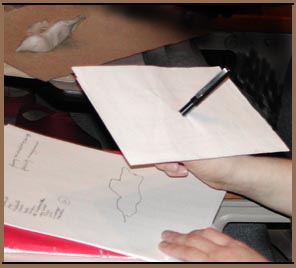
|
|

|
||
|
This is an example of a "beginning of class ritual "
©
Marvin Bartel,
2000
Age
Levels?
This ritual is probably appropriate for any age beginning from grade three through adults in senior citizen homes. Younger children may have some problems with the modeling method and the blind contour drawing methods used, but other parts of the experience work well with younger children. First grade children can begin to do some work from observation, but we need to be content with some "uneven" results. Outcomes? what is learned?
A writing and drawing tool. Ball-point pens are good. A piece of clay the size of a large hen egg wrapped in plastic or in a sandwich bag. Do not have it preshaped shaped like an egg. A six inch square of brown paper (similar to old grocery bags) or anything similar. A seven inch square "blinder card" or helper card (manila folder or tag board cards with small center holes to place on the ball-point so they can not see the drawing paper as they are drawing) A wet paper towel to wipe clay off of hands. A dry paper towel to finish cleaning. Teacher Instructions
|
||||
|
Historical
Connections
Many examples from art history could be used after the above hands-on experience. Here we see a beautiful 54 inch abstract sculptural interpretation of a bird in flight. It is most appropriate to lead a discussion of works such as this after students have experiences such as the above modeling and drawing ritual. The experience of making and drawing increases the likelihood of intuitive knowing, identification with, and understanding. The imperative for abstraction becomes more a obvious and natural solution. Their experience heightens both their need to know and their ability to know.
Conversely, to have shown the historical
example first,
will limit their ownership in their work. Secondly, they will have seen
the object as something to imitate rather than something to know.
Thirdly,
they will not have learned to create from their own insights and
experience
of the world. They will be encouraged to be dependent on others and
less
confident in their own creative facility.
|

Bird in Space 3 by Constantin Brancusi |
|||
|
FOOTNOTES:
1 Lowenfeld, Viktor and Brittain W. Lambert. Creative and Mental Growth , 6 th Ed. 1975 Maclmillan, N.Y. pp. 224-225. "Two methods of working with clay can be observed. One is that of pulling out from the whole and the other is that of putting single parts together. . . . Pulling clay out from the whole means to have a concept of the total, however vague, from which details will be developed: this method is called the analytic method. The other method . . . . putting single representative symbols together into a whole means the child is building up a synthesis of partial impressions: this method is called the synthetic method. 2 Chapman, Laura H. Approaches to Art in Education . 1978 Harcourt Brace Jovanovich, N.Y. p.54 "Changing Habits of Work. . . . The value of learning to 'shift gears' is widely acknowledged."
3
Gardner's Art Through the Ages, 5th ed.
revised
by de la Croix, Horst and Tansey, Richard G. 1970. Harcourt Brace and
World,
N.Y. p. 720, figure 17-33.
All rights reserved. Goshen College students may print a copy for their own use. Others must have permission to copy or publish. See these recently updated Links to many more essays and lessons by the same author Back to Art Rituals in the Classroom Essay Link to a list of drawing rituals . See other Art Education Essays by this author See an example of a List Making Game to get ideas for artwork. Back to Marvin Bartel Art for Children and Secondary School Art art education home page bartelart.com Goshen College Home |
||||
